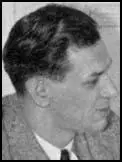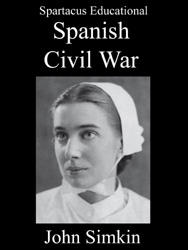Edward Knoblaugh

Edward Knoblaugh was a American journalist working for Associated Press in Madrid who went to Spain before the outbreak of the Spanish Civil War.
While in Spain he carried out interviews with several leading politicians including Julián Besteiro, José Calvo Sotelo, Niceto Alcalá Zamora, José Maria Gil Robles, José Antonio Primo de Rivera and Francisco Largo Caballero.
Knoblaugh left Spain during the Spanish Civil War. On his return to the United States he published Correspondent in Spain (1937). Knoblaugh also worked as a journalist during the Second World War.
Primary Sources
(1) Edward Knoblaugh, Correspondent in Spain (1937)
Azana's government had a difficult time maintaining order. There was a rash of strikes, violence, church burnings and other disorders. Virtually all the news coming out of Spain during my first nine months there dealt with these disorders. Each day would see some new form of violence-some phase of industry tied up or some blood spilled. Rex Smith, then bureau manager of the Associated Press in Madrid, once quite appropriately remarked that it might save us time and cable tolls if we had stereotyped forms made for New York and referred to them by number in indicating repetitions of violence.
The Azana government found itself obliged to use strong measures to curb the disorders. One of these incidents caused Azana's overthrow. Thirteen anarchists, having barricaded themselves in a cafe called Casa de Seis Dedos in the little village of Casas Viejas, fired on the police. The head of the Casas Viejas constabulary asked Madrid for instructions. The Ministry of Interior sent orders to the effect that the place should be cleaned up: "we want neither prisoners nor wounded." The police took these orders literally. Not one of the thirteen escaped alive
The extreme Left took up Casas Viejas as their war cry the thirteen men who had been killed by police bullets became martyrs. Public opinion was so aroused that, following Spanish tradition, it ended in reaction. The Right-Centre coalition of the then unknown newspaperman, Jose Maria Gil Robles, carried the November, 1933, elections in a sweeping upset. Azana was ousted. Gil Robles, by virtue of heading the largest parliamentary minority - the Popular Action group with 112 of the 473 Cortes votes - was first in line to succeed him. But President Niceto Alcala Zamora, although a strong Catholic, did not deem it wise to encourage a Right trend in parliament at that time. Instead, he named Lerroux, the veteran, to the post of Premier.
(2) Edward Knoblaugh, Correspondent in Spain (1937)
Cadiz, Caceres, Huelva, Sevilla, Granada and Cordoba were Franco's, as was the whole northern area of Spain from the Guadarrama mountains just north of Madrid to the Bay of Biscay, save a small strip of the Basque and Asturian coast. Huesca, Zaragoza and Teruel marked his lines on the east. He was in possession of the entire area bordering the Portuguese frontier on the west except a narrow strip in the vicinity of Badajoz.
In Madrid, Barcelona and Valencia, however, Franco's revolt had been crushed with a thoroughness that portended ill for the success of his movement. They were the three largest cities of Spain, and had been the key-points of the rebellion. Lack of coordination in Madrid, Valencia and Barcelona, was what caused the rebellion to miss fire there.
The government, having, in desperation, overruled President Azana and passed out arms to the workers, seemed as though it would turn the tables on the insurgent leader.
In that first urgent need for militant manpower to offset the traditional apathy of the peace-loving masses, 40,000 common prisoners had been released on their promise to carry arms, and these, with some 25,000 recently pardoned political prisoners gambling for continued freedom, had stiffened the disorganized Loyalist forces.
But the decision of Commander Martinez Monje, chief of the Valencia garrison, to throw his support to the government, was the deciding factor in the issue at that time. For ten days Commander Monje held his troops in their barracks while he carefully weighed the odds. When the Montana barracks fell before the militia in Madrid, and the Barcelona revolt had been crushed, Monje decided Franco's chances were slim and cast his lot with the government. Franco must have cursed the thought of Monje many times since.
(3) Edward Knoblaugh, Correspondent in Spain (1937)
Jose Antonio Primo de Rivera, son of the former dictator and organizer of the Spanish Nationalist Syndicalist Party, was one of those executed in the general "liquidation" of Rightist leaders at the outset of the war. Independence of thought and action had characterized Primo's brilliant political career. He declined to ally himself with the Gil Robles coalition in the 1936 elections although he knew that his refusal virtually assured defeat for the National Syndicalists. Primo bitterly resented the fact that this party frequently was referred to as "fascist." The National Syndicalists supported the Catholic Church but apart from the religious issue their policies were almost identical with those of the C.N.T.
The 33-year-old political leader, although of slight physical build, had gained a reputation as a fighter during his one term as deputy to the Cortes. When heckled during his impassioned pleas for social reform or when some slurring remark on the memory of his dead father was passed by a critic of the Rivera administration, young Primo had often scrambled over the benches of the chamber and engaged in hand-to-hand affairs with fellow deputies. Soon after the February elections Primo was imprisoned for his caustic criticism of the new regime. In public speeches and editorials in his weekly newspaper Primo declared that the "failure of the government to prevent destruction of Rightist property or to punish those responsible for the destruction demonstrated the impotency of the new Popular
Front government to govern."
Inasmuch as many of his attacks had been leveled directly at the Anarchists, he was one of the first to be marked for death by the CNT-FAI, following the outbreak of the war.
The government, realizing that Primo enjoyed considerable popularity in many quarters abroad, made an effort to save his life. Largo Caballero took a particular interest in the case because word had been sent him that his young son, whose name I never secured, was being held as a hostage by the Rebels and that Primo's death would mean the boy's death. Primo was spirited incognito to Alicante after the government had caused reports to be circulated that he had died in prison, but the ruse failed. The Anarchists traced Primo to his secret dungeon cell in the Alicante prison and threatened to storm the prison unless he was delivered to them. They finally agreed to the pleas of the Governor of Alicante that Primo be given trial. He was tried. The trial was such a farce that correspondents were not permitted to attend the sessions or to cable anything of the proceedings after the first day.
Primo was executed November 20, 1936, by a militia firing squad. The government did everything possible to prevent news of the execution from reaching abroad but it leaked out through Gibraltar several days later and we were permitted to confirm it. Largo went into mourning. We supposed he had heard his boy had been shot.
(4) Edward Knoblaugh, Correspondent in Spain (1937)
I made a tour of the Barcelona churches and Rightist centers which the Left extremists had pillaged and burned since my previous visit. A large number of churches and convents had been destroyed during the demonstrations following the Left election victory in February. The work of destruction had been completed during the week preceding my arrival. Only the blackened walls remained of the historic religious buildings. The statues and paintings had been destroyed or removed, the altars ripped out, the stained-glass windows broken. The burial vaults in the floors of some of the churches had been forced open and the century-old mummified bodies of nuns and priests had been removed from their mouldy resting-places. On the steps of the Carmelite church were arrayed a dozen or more of the skeletons of nuns in standing and reclining postures.
The red and black flag of the Anarchists was everywhere - hung from balconies, suspended from cords strung across the thoroughfares and fastened to sticks wired to the fronts of commandeered automobiles. No attempt was being made to police the city. Scowling through their week-old beards, the militia, dressed in blue overalls or simply in denim trousers and dirty shirts, with red and black neckerchiefs about their throats, were as thick as flies. Lounging here and there or speeding through the streets in their requisitioned private cars with the black snouts of submachine guns protruding over the window sills, these Catalonian Anarchists looked fierce enough to startle even the directors of a Hollywood mob scene. Occasionally a shot was heard as a rifle in inexperienced hands was discharged.

